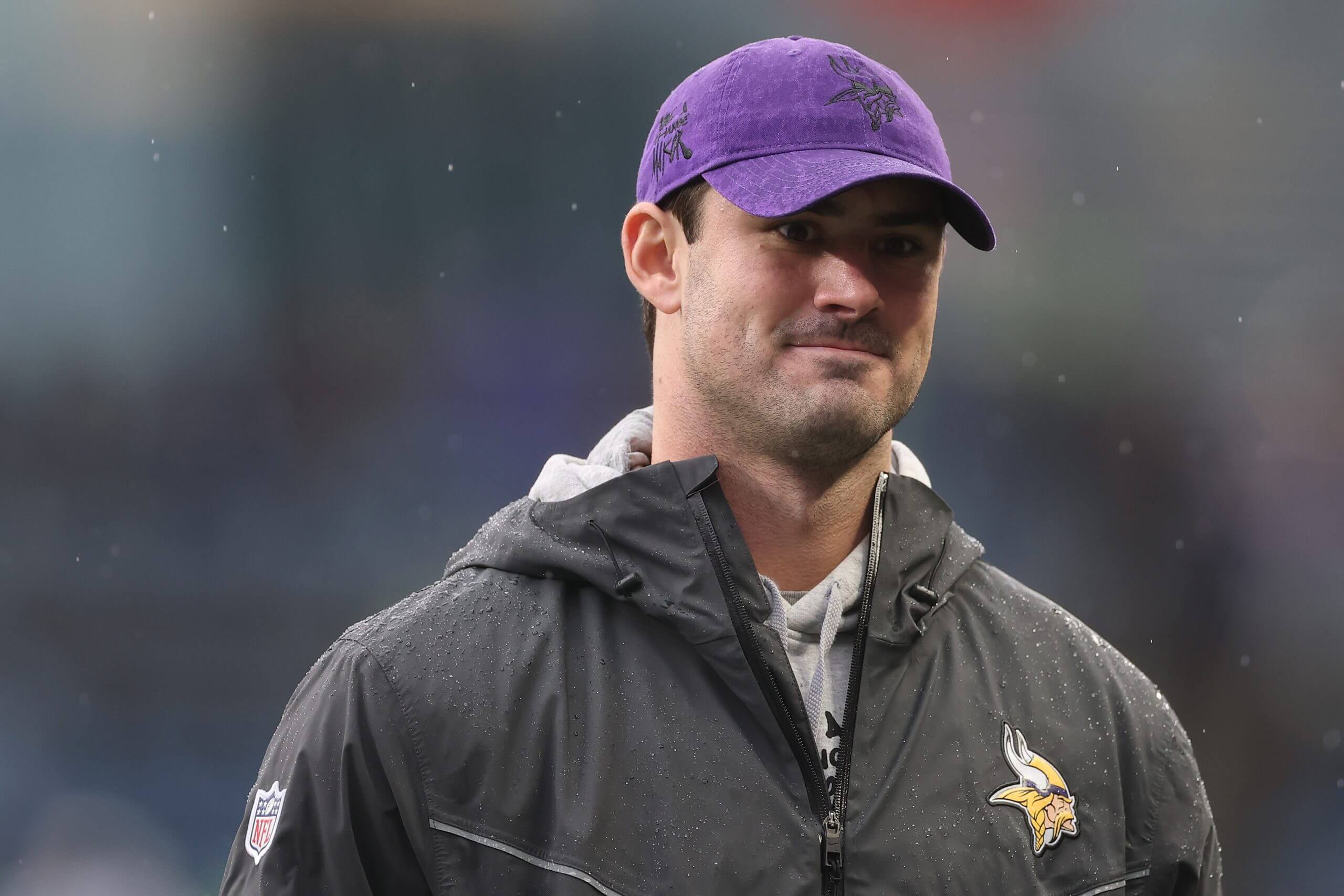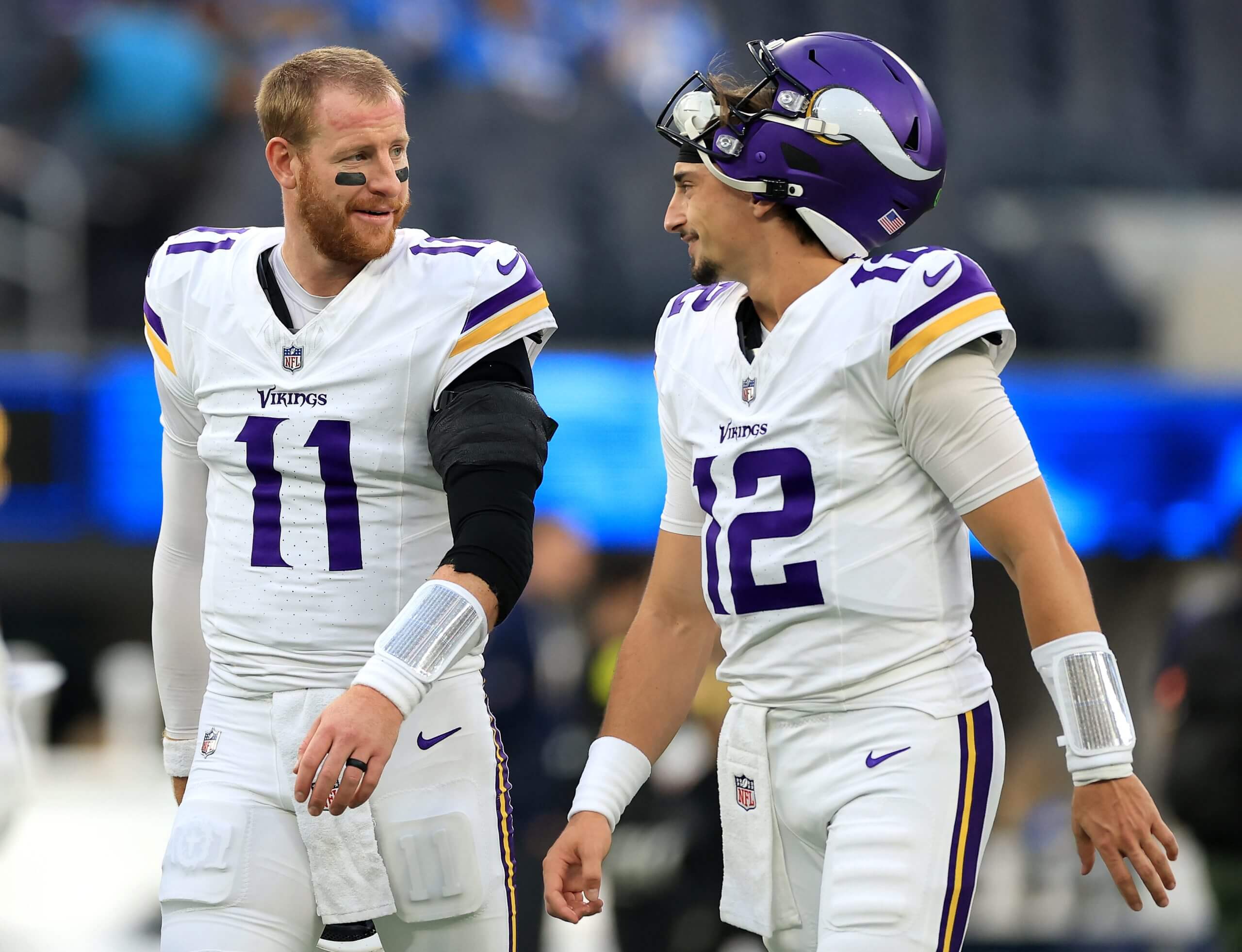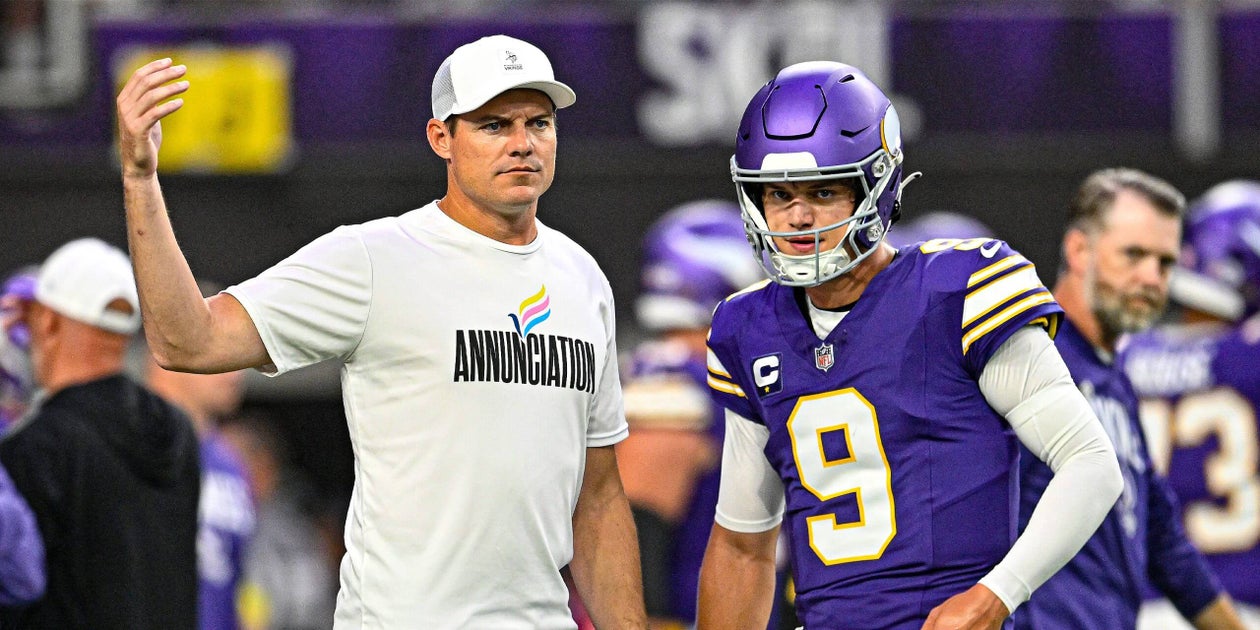The Minnesota Vikings — the organization perpetually in search of a franchise quarterback — will instead resume their choppy journey with young J.J. McCarthy, the 10th pick of the 2024 draft, who’s set to return from a seven-week absence and make his third NFL start Sunday in Detroit.
The dudes in purple don’t need a blast from the past, and thus won’t be trading for a 37-year-old whose most recent performance, as an Atlanta Falcons fill-in, didn’t exactly evoke memories of his glory days.
What the Vikings could really use as we prepare to turn back the clocks an hour is something a bit more extreme: a time machine.
Since March of 2024, when Cousins left Minnesota to sign a four-year, $180-million deal with the Atlanta Falcons at the start of free agency, the Vikings have ripped through a slew of quarterbacking scenarios that involve some of the NFL’s most productive passers of the moment. In less than a year, the Vikes tried to trade up for Drake Maye, enjoyed a season of Sam Darnold’s renaissance, spurred Daniel Jones’ revival and pondered a high-profile overture from Aaron Rodgers.
All of those QBs are playing at a high level for teams with winning records.
The Vikings (3-4), a team ostensibly built to win now, are still struggling to identify their triggerman of the present and future.
If, as Wayne Gretzky said, you miss 100 percent of the shots you don’t take, Minnesota is in danger of becoming the NFL’s Exhibit A.
When you lead the league in cash spending ($343 million in 2025) and have already lost more games before Halloween than you did in the entire 2024 regular season, there will be plenty of second-guessing, both from inside and outside the franchise’s state-of-the-art training facility.
Knowing what they know now, if the Vikings’ powerbrokers (owners Zygi and Mark Wilf, general manager Kwesi Adofo-Mensah and head coach Kevin O’Connell) could request a do-over, they might well pursue a different strategy at the sport’s most important position.
Instead, as all of us must, the last-place Vikings will live in the moment. And beginning with Sunday’s showdown with the 5-2 Lions at Ford Field, they’ll be focused on what is essentially a 10-game referendum on McCarthy’s status.
If the young quarterback shines, as he did during a transcendent fourth quarter on the first Monday night of the season, he’ll have a firm grip on the job that was handed to him last spring, and the Vikings will continue to build around him.
Should McCarthy struggle, as he did in a Week 2 defeat to the Falcons, the organization will surely explore viable alternatives at season’s end.
And if McCarthy gets hurt — again — to garner an “incomplete” grade and prevent a more comprehensive evaluation? Given the prevailing questions about his durability, that will be an answer unto itself, and one that is strikingly similar to the second, less favorable hypothetical. (If McCarthy were to sustain a long-term injury in Sunday’s game, two days before the trade deadline, perhaps a Cousins reunion could then be on the table.)
Would it be fair to sour on McCarthy because he can’t stay healthy at the start of his career? Of course not — but nothing about the NFL is especially fair. Just ask Los Angeles Chargers backup quarterback Trey Lance who, despite being the third pick of the 2021 draft, made only four starts with the San Francisco 49ers before they traded him after two injury-plagued seasons.
It’s not McCarthy’s fault that he suffered a season-ending torn meniscus in his first preseason game as a rookie or that, in September, he sustained a high ankle sprain against the Falcons that lingered for a month and a half. And he certainly can’t be castigated for missing an important practice three days before his second career start to be with his fiancée for the birth of their son, spending three nights at the hospital in the process.
His small body of work — seven subpar quarters, and a tremendous 15-minute stretch against the Chicago Bears that propelled him to an NFC Offensive Player of the Week award — suggests that the former Michigan star is very much a work in progress. And because of bad luck, and O’Connell’s high standard of expectation at the position, McCarthy’s growth curve will now have to become much steeper.
For now in Minnesota, it’s still J.J. or bust. Will that mindset soon be replaced by J.J.’s a bust? Not if McCarthy plays well enough to remind people why the Vikings traded up a spot to draft him.
Given O’Connell’s track record, there’s ample reason to believe this is possible. Last season, he won Coach of the Year honors while reaffirming his status as one of the sport’s elite quarterback whisperers, thanks to Darnold’s breakout performance.
Darnold, who’d signed a one-year deal before the season, was so good for most of 2024 that it seemed unfathomable that the Vikings wouldn’t bring him back, either via the franchise tag or a lucrative long-term deal. However, he played poorly enough in each of Minnesota’s last two games — the regular season finale against the Lions, which decided the NFC North title and conference’s No. 1 playoff seed, and a first-round playoff defeat to the Los Angeles Rams — that the Vikings didn’t fight to keep him in free agency. Their offer was far less attractive than the three-year, $100.5 million contract he landed from the Seattle Seahawks, which now looks like a bargain: Seattle (5-2) is tied with the Rams atop the NFC West, and Darnold (109.2 passer rating) has been among the league’s top passers.
The Vikings had their reasons for letting Darnold leave. Their investment in McCarthy, both emotionally and practically, remained a guiding force. For decades, the organization has been searching for a true franchise quarterback it could draft, develop and depend upon; Daunte Culpepper, a first-round selection in 1999, was the closest thing to that before a severe knee injury derailed his career six years later.
The Wilfs, who bought the franchise shortly before Culpepper got hurt in 2005, are intent on finding out if McCarthy can finally fill that void. And many Vikings fans share that conviction, and really, really want it to happen.
In that context, bringing back Darnold was problematic. He and McCarthy did not forge an especially close relationship during their time together, and it would have been hard to envision the untested youngster winning a fair competition. The vibe didn’t seem right for such an arrangement.
Besides, the Vikings had a backup plan.
That plan was Jones, a former New York Giants starter whose high point with the franchise was a 31-24 road playoff victory over the Vikings in O’Connell’s first season (2022). Released last November after losing eight of his 10 starts in 2024, Jones deliberately plotted his next move, with 15 teams pining for his services as a backup or practice-squad addition. O’Connell spent a lot of time and energy wooing him, even amid game-plan preparations, expressing the conviction that Jones, like Darnold, could reboot his career by assimilating into the Vikings’ ecosystem.
It worked: Less than a week after his release, Minnesota signed Jones to a $375,000 deal to join the team’s practice squad. Jones was promoted to the active roster in advance of the team’s playoff game against the Rams. In the weeks that followed, O’Connell pitched him hard on the idea of returning in 2025, insisting that he’d be given a chance to compete with McCarthy.
Free agency was fast and furious, and the Vikings lost the race. After Darnold agreed to terms with the Seahawks last March, O’Connell and Adofo-Mensah felt confident that Jones would sign with Minnesota. The next day, however, Jones surprised them by agreeing to a one-year, $14-million deal with the Indianapolis Colts, rejecting a slightly bigger offer from the Vikings that also included more guaranteed money.

Daniel Jones landed with the Vikings during the 2024 season, but he chose the Colts in free agency. (Steph Chambers / Getty Images)
Why the miscalculation? For starters, Jones correctly surmised that he had a good chance of beating out struggling Indy incumbent Anthony Richardson, the fourth pick of the 2023 draft. And in the end, O’Connell’s greatest strengths — the Vikings’ player-friendly culture, and the coach’s previous success with quarterbacks — may have worked against him. Jones expressed to the Vikings that, given the team’s infrastructure, he didn’t see how McCarthy could fail.
It’s also impossible to argue with Jones’ decision: He currently has the NFL’s sixth-highest passer rating (109.5) for the 7-1 Colts, who own the league’s best record.
At that point, only one attractive veteran option remained for the Vikings as a hedge against McCarthy failing: Aaron Rodgers. The coach had long been friendly with Rodgers, a four-time MVP and future first-ballot Hall of Famer, who was coming off a pair of challenging seasons with the New York Jets. Rodgers, 41, wanted to sign with Minnesota, and the organization strongly considered it.
However, O’Connell and his fellow decision-makers ultimately balked, because they felt delaying McCarthy’s debut for (at least) another season would inevitably stunt his growth. Rodgers eventually signed with the Pittsburgh Steelers and has played well (16 touchdown passes, five interceptions, 104.4 rating) for the AFC North leaders. Arguably, it’s the best Rodgers has looked since 2021, his second-to-last season with the Green Bay Packers, when he captured his fourth MVP. Presumably, the Vikings didn’t see that coming.
On paper, this was a sound long-term decision: O’Connell, who’d received a lucrative contract extension through 2029 in January, and Adofo-Mensah, who would sign an extension later that spring, were intent on building a consistent winner, rather than finding a quick fix. Yet the Vikings approached the offseason like an organization heavily focused on the present, signing weathered veterans like defensive tackles Jonathan Allen and Javon Hargrave and center Ryan Kelly to lucrative free-agent deals.
The way O’Connell and Adofo-Mensah viewed it, having a starting quarterback on a rookie deal allowed Minnesota to load up at other positions. However, that model required McCarthy to play well from the jump and avoid injury.
Suffice it to say, things haven’t gone according to plan. And that includes the backup plans.
The Vikings’ projected No. 2 quarterback — former Washington Commanders starter Sam Howell, acquired in an April trade with the Seahawks — had a horrible training camp and was flipped to the Philadelphia Eagles in August. (He’s currently a third-stringer in Philly.)
To replace Howell, the Vikings signed 32-year-old Carson Wentz, who joined his sixth team since 2020. With little time to absorb O’Connell’s offense, Wentz, who replaced the injured McCarthy after Week 2, ran a hybrid scheme that included some plays and concepts with which he was already familiar. After winning two of five starts, and playing through a painful torn labrum in his left (non-throwing) shoulder suffered in an Oct. 5 victory over the Cleveland Browns in London, Wentz was placed on injured reserve Monday.
That leaves undrafted rookie Max Brosmer as McCarthy’s backup. Brosmer, who spent his senior season at nearby Minnesota after transferring from New Hampshire, impressed coaches in training camp and the preseason by getting the ball out quickly, seeing the field well and making accurate throws. Internally, there have even been some comparisons with 49ers quarterback Brock Purdy, a 2022 seventh-rounder (he was the final pick of the draft) who made Lance expendable after stepping in and performing well late in his rookie season.

Carson Wentz (left) and Max Brosmer were atop the Vikings’ depth chart before a loss against the Chargers. (Luke Hales / Getty Images)
If Brosmer ends up playing in 2025, that won’t be a cause for celebration in the Vikings’ training facility. It will have meant McCarthy’s stock has fallen, either because of injury or ineffectiveness — and it will bring up a lot of questions about how Adofo-Mensah and O’Connell might approach the upcoming offseason. The Vikings are currently $36.2 million over the salary cap for 2026, making the pursuit of a high-priced veteran alternative even trickier.
A highly preferable development would be for McCarthy to begin fulfilling his promise and showing his superiors that their faith in him has been justified. Unlike Maye, the quarterback selected with the third pick in 2024 by the New England Patriots (who rebuffed the Vikings’ efforts to trade up for the pick), McCarthy didn’t have a chance to fight through rough patches as a rookie in a relatively low-stakes setting. Maye’s maiden effort for the 4-13 Patriots set the stage for a breakout campaign in Year 2: The AFC East-leading Pats (6-2) are one of the NFL’s unlikeliest first-half success stories, and Maye, who has completed a league best 75.2 percent of his passes and whose 118.7 passer rating is second only to Lamar Jackson’s, heard MVP chants last Sunday at Gillette Stadium.
As McCarthy’s value to the Vikings continues to evolve, he’s stepping into a tougher spot than his bosses once envisioned. This team was conceived as a well-rounded unit that wouldn’t require extraordinary quarterback play to succeed, but injuries (especially on the offensive line) and execution issues have plagued them to this point. On offense, they’ve struggled to run the ball consistently, convert on short yardage and protect the quarterback. Their run defense and interior pass-rush production have been shaky, too, among other frustrations.
O’Connell, Adofo-Mensah and the team’s other powerbrokers didn’t expect it to play out this way. In retrospect, they’d likely have done some things differently — especially at quarterback.
Yet in football, as in life, there are no time machines. Looking back isn’t very helpful; you can only trudge forward and try to forge a fruitful path.
That’s especially true for McCarthy. If he can make some big strides over the next 10 weeks, both the Vikings’ recent past and the immediate future will start to look a whole lot better.
